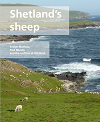
This richly illustrated book is a comprehensive guide to the history, management and marketing of the iconic sheep of Shetland.
Obtainable direct from us or from Amazon.co.uk: https://tinyurl.com/shetlandssheep
The first chapter, "Crofting", covers the history of crofting and the significance of sheep to Shetland's modern economy.
Chapter 2, "Keeping sheep", focuses on history of the Shetland Sheep breed, the genetics governing its rich range of colours and patterns, and the Shetland Flock Book Trust's standards. It also covers the intricate management system that crofters use to raise sheep on the rough hills and kinder "inby" fields of the Shetland archipelago.
Chapter 3, "Wool", explains how a freshly shorn fleece is spun into yarn, which is then knitted into garments or woven into cloth. Sections cover Fair Isle knitting, lace, weaving, rugs and carpets, sheepskins and felt, as well as the retail industry.
Chapter 4, "Live animals and meat", explains how sheep are marketed, slaughtered and turned into everything from noisettes to Valentine steaks. There is even a traditional recipe for how to make enough reestit mutton to last a family through the winter ("Take 6 sheep..."). This chapter also covers the economics of keeping sheep in Shetland, and shows how the most valuable product from a sheep is not the wool or meat, but the lambs that are sold on for fattening.
The final chapter, "What's where?", lists the many organizations involved in the sheep and wool industry in Shetland, including events, museums, breeding organizations, wool designers and retailers, and butchers.
Scattered throughout the book are amusing and interesting snippets, such as a guide to sheep psychology ("fences are interesting challenges rather than insurmountable barriers"), hints for visitors ("don't ask a crofter how many sheep they have"), instructions on how to find out how old a sheep is, and the story of the sweaters that Sir Edmund Hillary's team wore when they conquered Everest.
